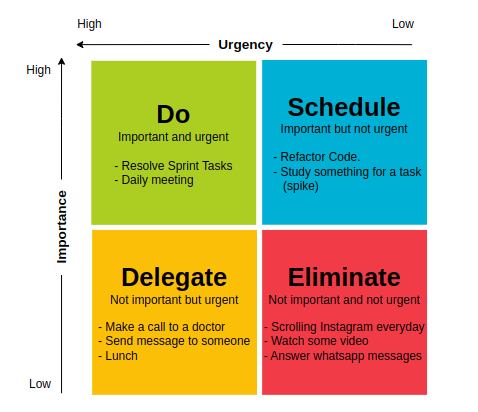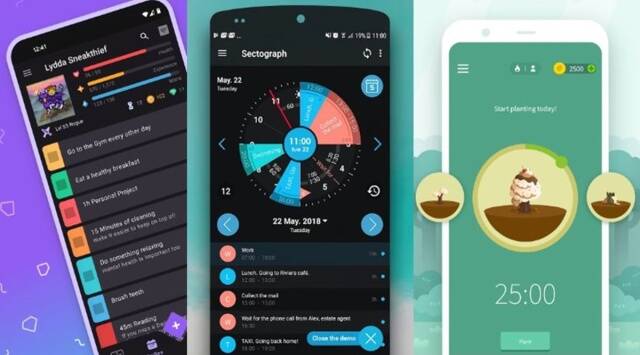Maximizing Time Optimization while Working Remotely: Organization for a Balanced Life
As software developers, you know how crucial it is to find the right balance between work and personal life. It's easy to fall into the trap of working non-stop, but remember that it's also important to take care of yourselves and enjoy other aspects of life. We don't want you to become robots programming all the time!
That's why we're going to explore some tools that will help you optimize your time and find that much-needed balance.
Eisenhower Matrix
This simple yet powerful tool will help you prioritize your tasks and avoid procrastination. The matrix divides tasks into four categories:
- Urgent and important
- Important but not urgent
- Urgent but not important
- Neither urgent nor important
Sounds interesting, right?
Imagine you're working on a software project and you have multiple tasks to do. The key is to identify the urgent and important tasks, which are the ones that must be done immediately. These tasks may include fixing critical bugs or meeting tight deadlines. Once you've completed those tasks, you can move on to the important but not urgent tasks, which are the ones that contribute to the project in the long run but don't have an immediate deadline. This could be improving the user interface or refactoring the code.
Of course, there will also be tasks that are urgent but not important. These are the ones that need to be addressed but not necessarily by you. They could be requests from other team members or interruptions that arise during the day. It's important to learn to delegate these tasks when possible so that you can focus on what really matters.
Finally, there are tasks that are neither urgent nor important. These are the ones you should avoid at all costs. Sometimes, you may fall into the trap of wasting time on social media or non-productive activities. But don't worry! With practice and awareness, you can learn to recognize and eliminate these distractions.

Pomodoro Technique
This technique, named after a tomato-shaped timer (yes, a tomato!), is ideal for improving concentration and productivity. It is based on working in short and focused time blocks, followed by brief breaks.
Here's a quick explanation: choose a task and set the timer for 25 minutes. During those 25 minutes, work on that task without any distractions. When the timer goes off, take a short 5-minute break. Repeat this cycle three or four times and then take a longer break of 15 or 30 minutes.
This technique is especially effective for maintaining focus and avoiding mental fatigue. By breaking the work into smaller blocks and having regular breaks, it will be easier for you to stay focused and avoid procrastination. Additionally, it also gives you the opportunity to stretch your legs, rest your eyes, and recharge before getting back to work.

Tasks automation
As software developers, you have technical skills that can be leveraged to automate repetitive or time-consuming tasks. Think about those tasks you perform daily that don't require constant manual intervention. Is there a way to create scripts or use tools that allow you to automate those tasks? Automation will save you time and free up energy to focus on more creative and high-value tasks. Today we have ChatGPT or AutoGPT, which also help optimize our time when it comes to writing lengthy documentation or generating reports. (Being objective enough, we need to review the work it produces since it is still a software generating it).
ChatGPT time optimization guide
Step 1: Set your weekly goals before you begin, it's important to define your weekly goals. What tasks and objectives do you want to achieve during the week? Make a list of the most important activities you need to accomplish in your work and studies.
Step 2: Determine available time now, identify the available time in your schedule from 9 to 18 to study and complete your work tasks. Make sure to consider breaks and meals. For example, if you have an hour for lunch, you can allocate part of that time for studying.
Step 3: Establish a specific schedule once you have identified the available time, it's time to establish a specific schedule. Divide your time into blocks and assign each block to a specific task or activity. For example, you can dedicate the first two hours of the morning to studying, followed by two hours for work tasks, and so on. Make sure to be realistic and consider your levels of concentration and energy during different times of the day.
Step 4: Use ChatGPT to optimize your schedule, this is where ChatGPT can be of great help. You can ask specific questions to get recommendations on how to structure your schedule more efficiently. For example, you can ask:
- "What's the best way to organize my study tasks in the morning to maximize my concentration?"
- "What can I do during breaks to relax and recharge effectively?"
- "How can I balance my time between work tasks and study activities more efficiently?"
Based on your questions, ChatGPT will provide suggestions and recommendations to optimize your schedule and make the most out of your available time.
Step 5: Evaluate and adjust your schedule Once you have received recommendations from ChatGPT, according to your needs and preferences. Remember that each person is unique, so some suggestions may not fit perfectly with your situation. Experiment with different approaches and find the structure that works best for you.
Step 6: Follow the schedule and track progress Once you have established your optimized schedule, it's important to follow it in a disciplined manner. Keep a record of your progress and track how you feel with this new approach. Make adjustments if necessary and be flexible with your schedule when unexpected events occur.
Remember that ChatGPT is a useful tool, but it's also important to trust your own judgment and knowledge. Use the recommendations as guides but adapt the suggestions to your personal situation.
I hope this short article can be useful to you, just as it is to me.
I'll leave a script down below so that you can also create a table with ChatGPT and directly copy and paste it into a document where you can have it at hand, or print it out and place it on a whiteboard to visually review the tasks and the time you need to allocate to each of them.
English
"I need you to act as a personal advisor with 15 years of experience specializing in [specific need of the field] (e.g., advising software professionals on optimizing their time during their workday). I need you to provide me with a guide in the format of a [table/list] where the columns represent the days of the week, and the rows contain time slots of [time in minutes], and assign the following list to each of the blocks: [list of each task] [take into account tasks that repeat like a daily, every day at the same time, clarify it at the end of the list]. Keep in mind that my main objective is: [studying x technology / studying for x exam / completing my tasks as soon as possible], and I would like to use the Eisenhower Matrix to organize them in the most efficient way possible."
Spanish
"Necesito que actúes como un asesor personal con 15 años de experiencia en donde te especializaste en [ Necesidad específica del área ] (por ej: Asesorar a profesionales del mundo del software a eficientizar los tiempos durante su jornada laboral). Necesito que me brindes una guía en formato de [ tabla / lista ] donde las columnas sean los dias de la semana, y las filas, contengan las franjas horarias cada [ tiempo en minutos ] y asignes el siguiente listado a cada uno de los bloques:
[ listado de cada una de las tareas ]
[ tener en cuenta las tareas que se repiten como una daily, todos los dias al mismo horario, hay que aclararlo al final del listado]
Ten en cuenta que mi objetivo principal es: [ estudiar x tecnología / estudiar para x examen / terminar mis tareas lo antes posible ] y quisiera utilizar la matriz de Eisenhower para organizarlas de la manera más eficiente posible".
Here an example

I asked him to schedule the daily meeting for me every day at 9, and my main goal was to learn AWS. If you're in a sprint with a heavy workload, you can adapt it and set "Completing my X tasks for the sprint" as your main goal, and thus establish what you need.

